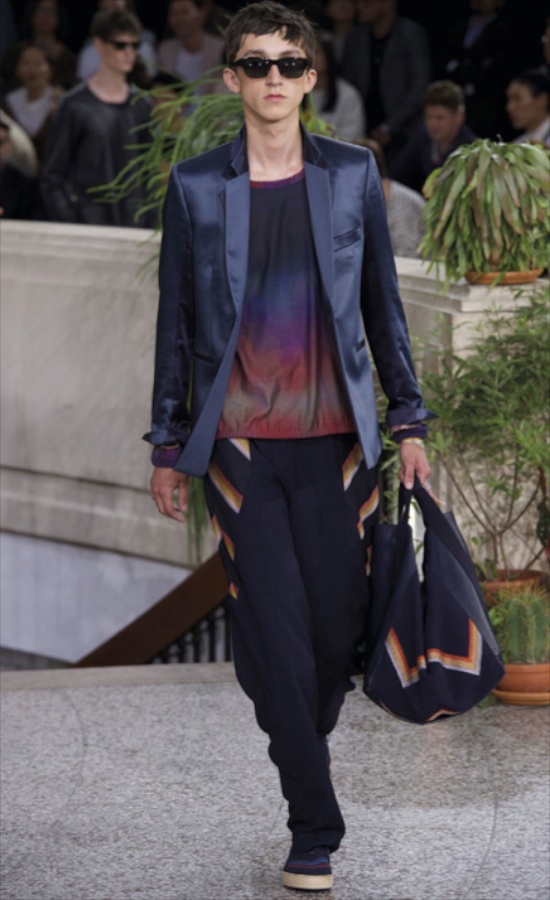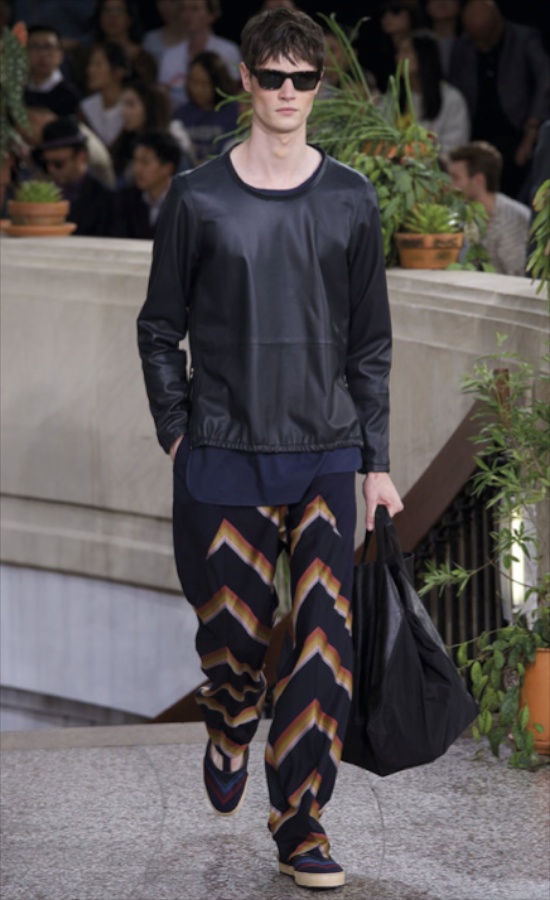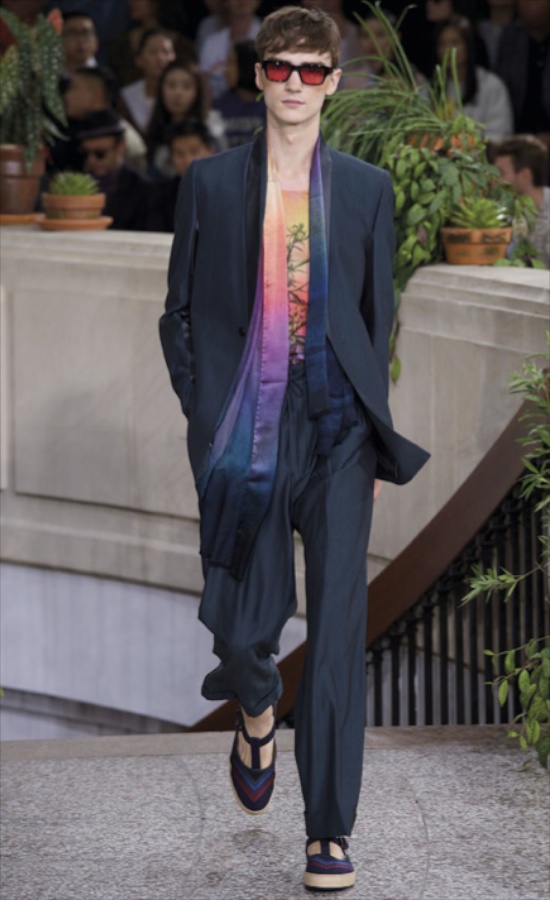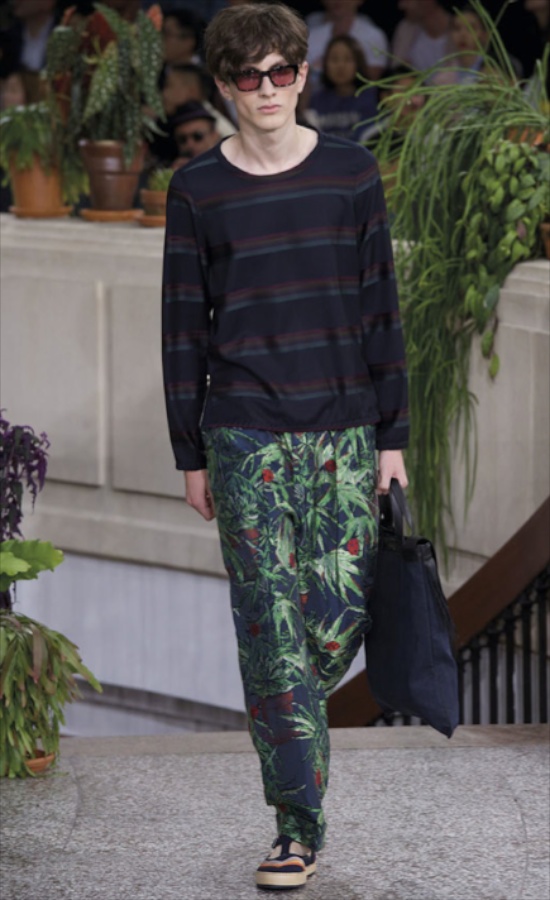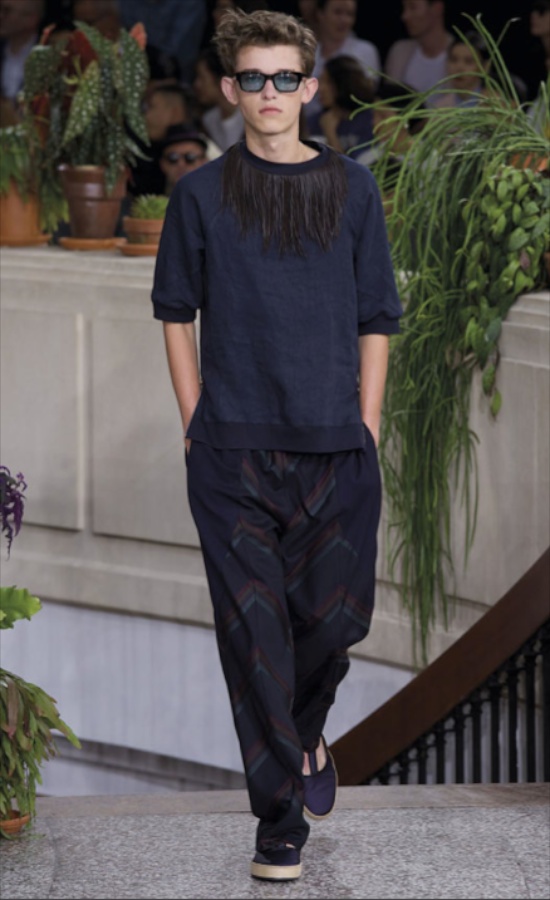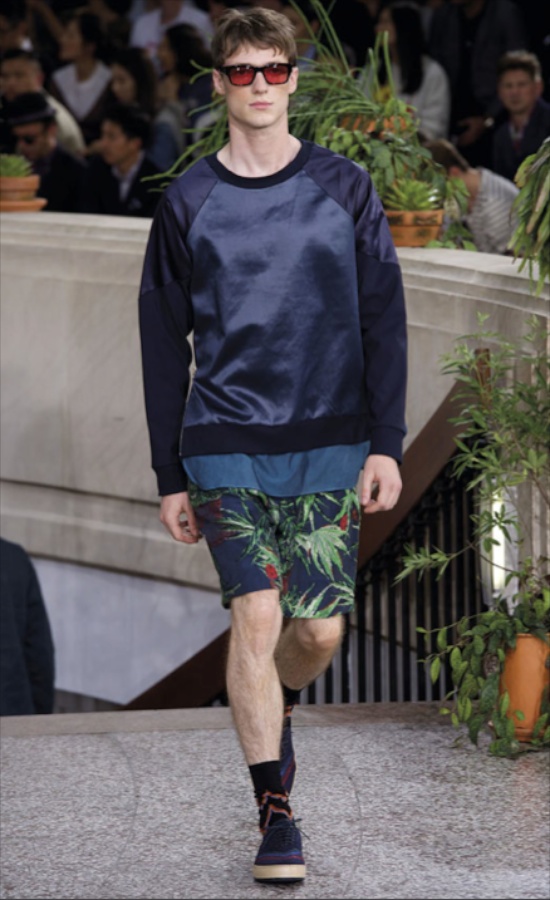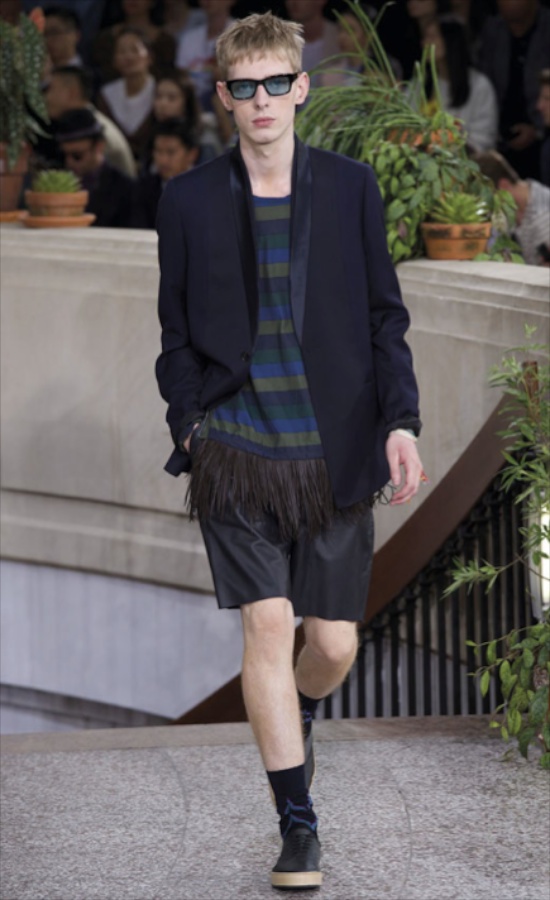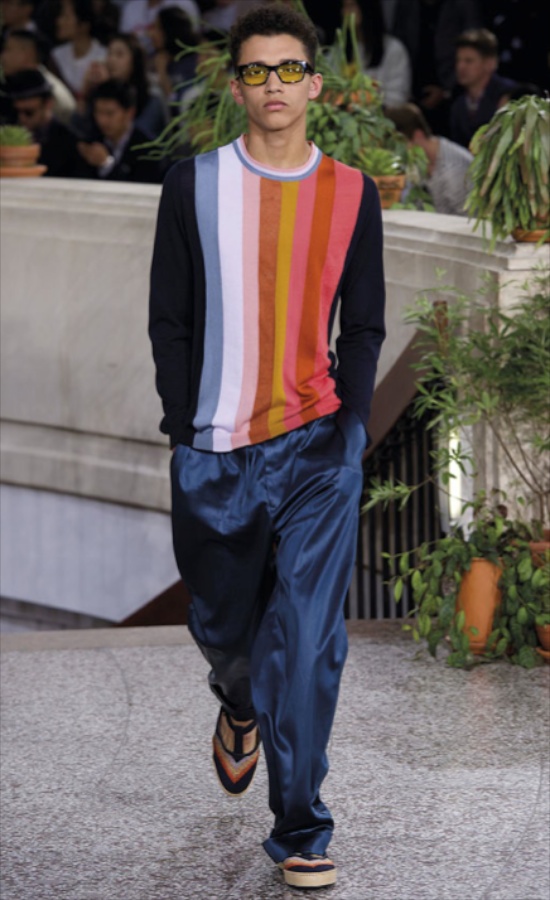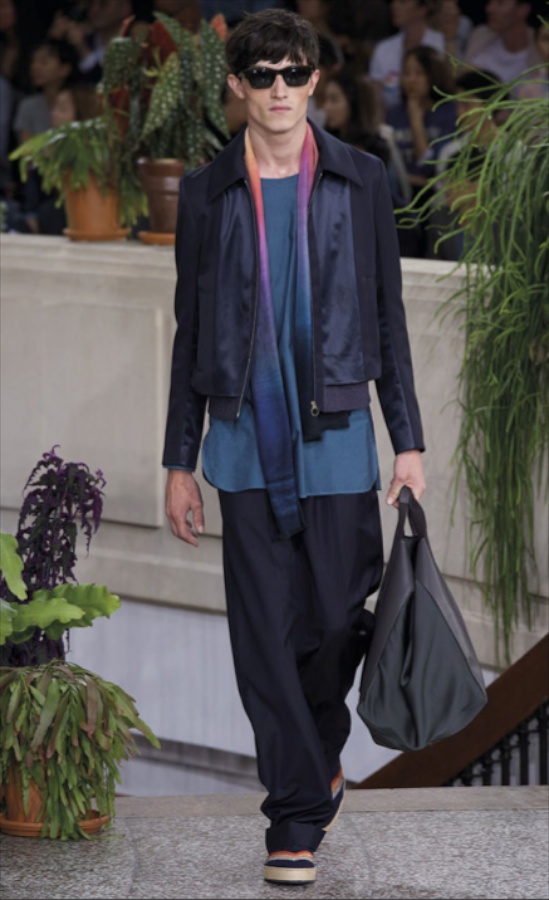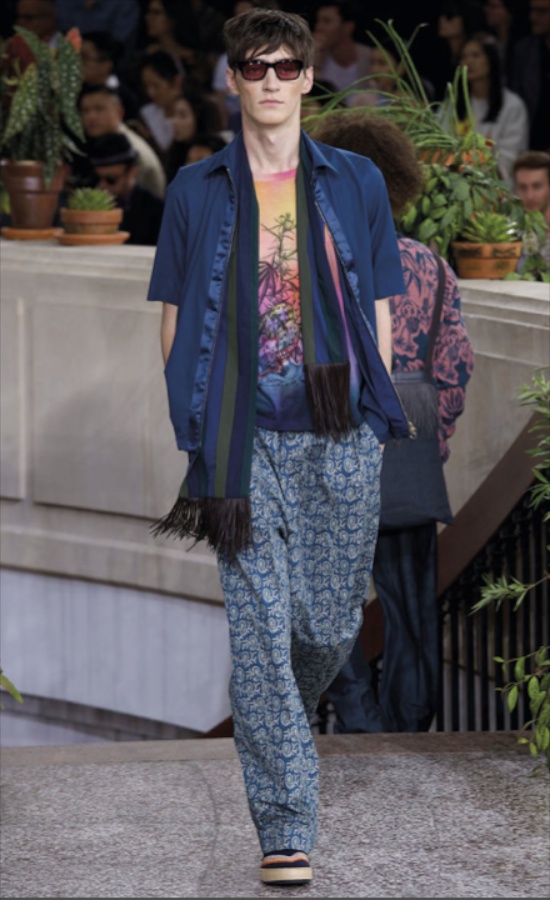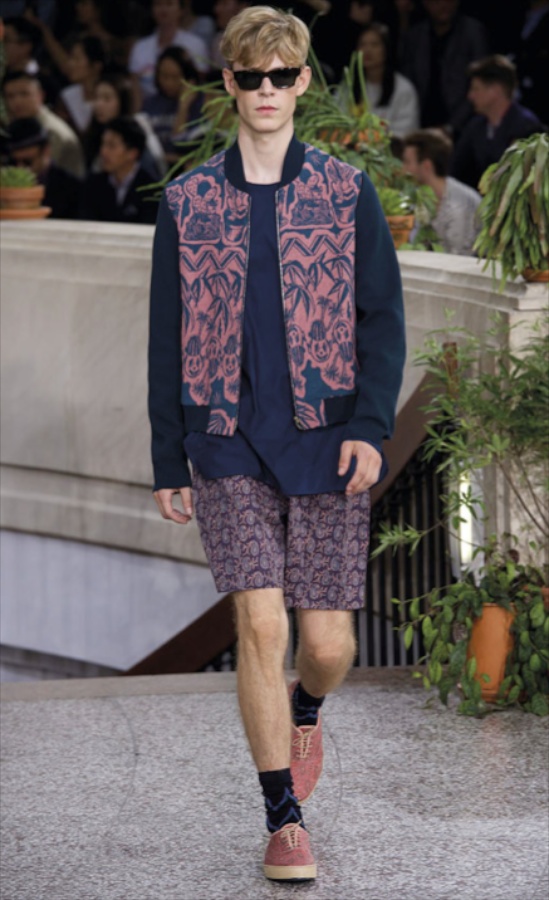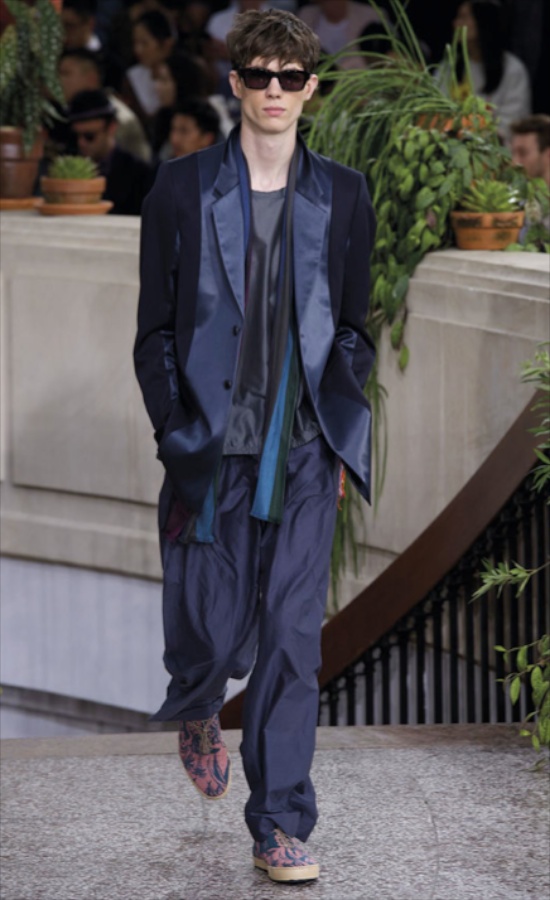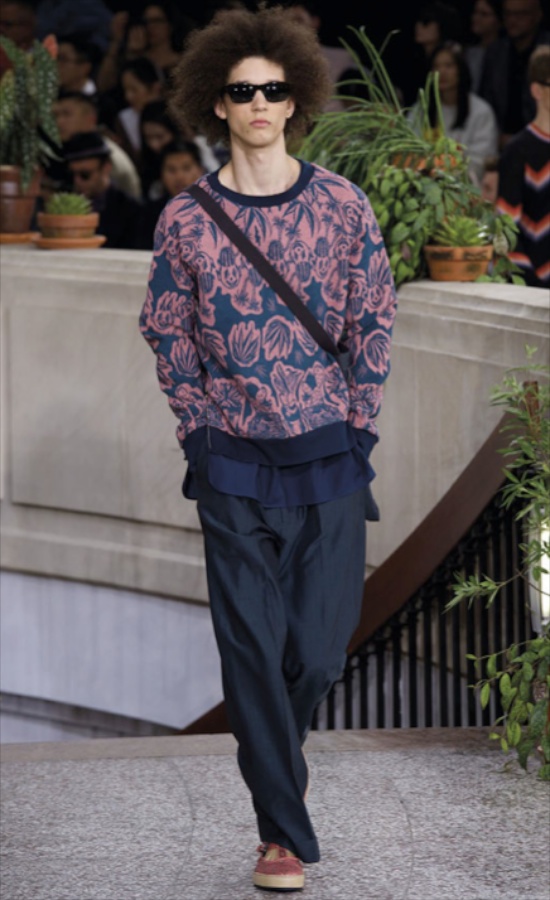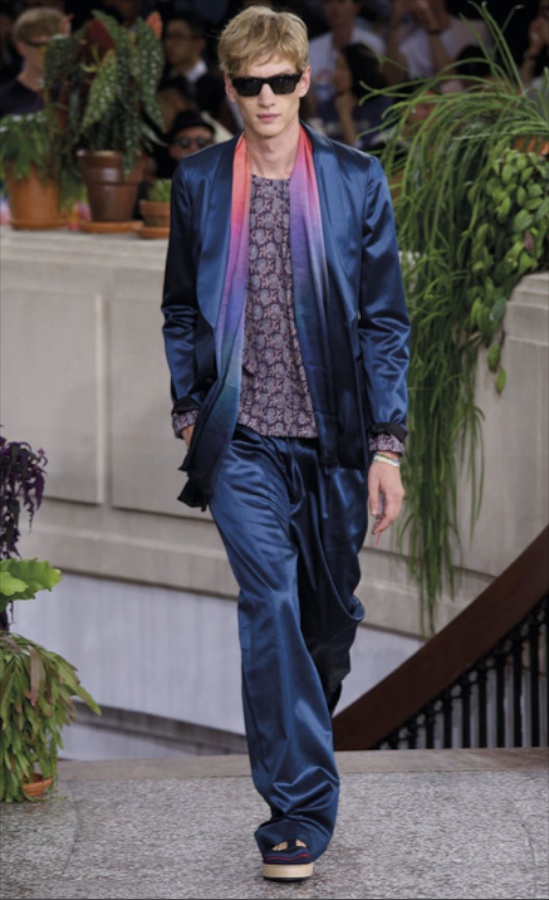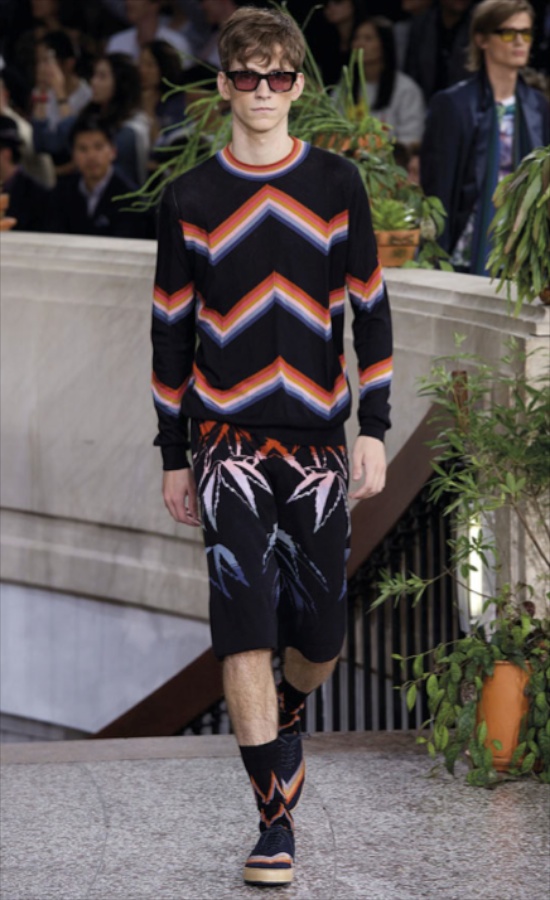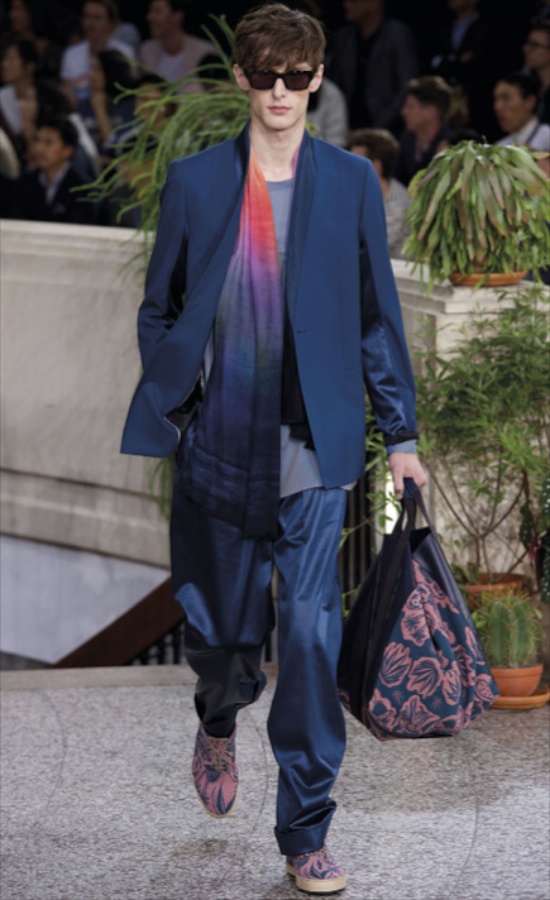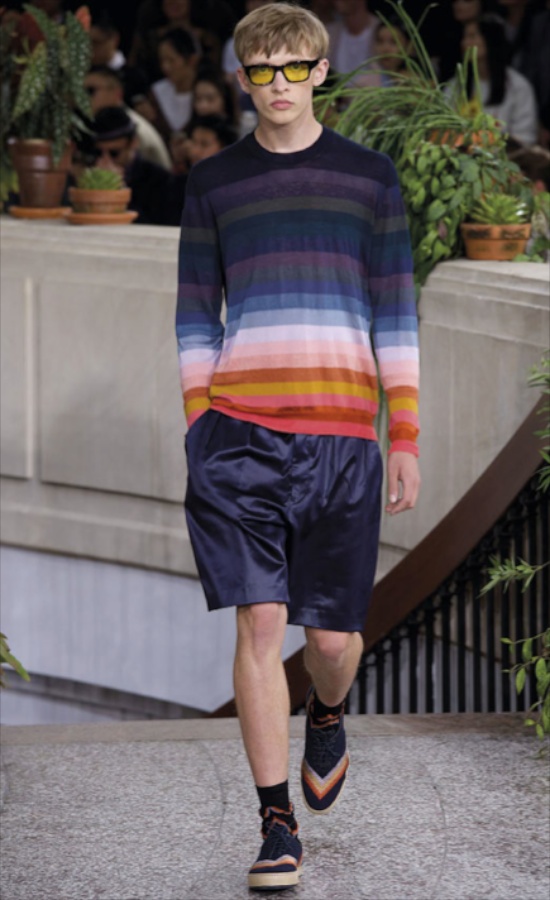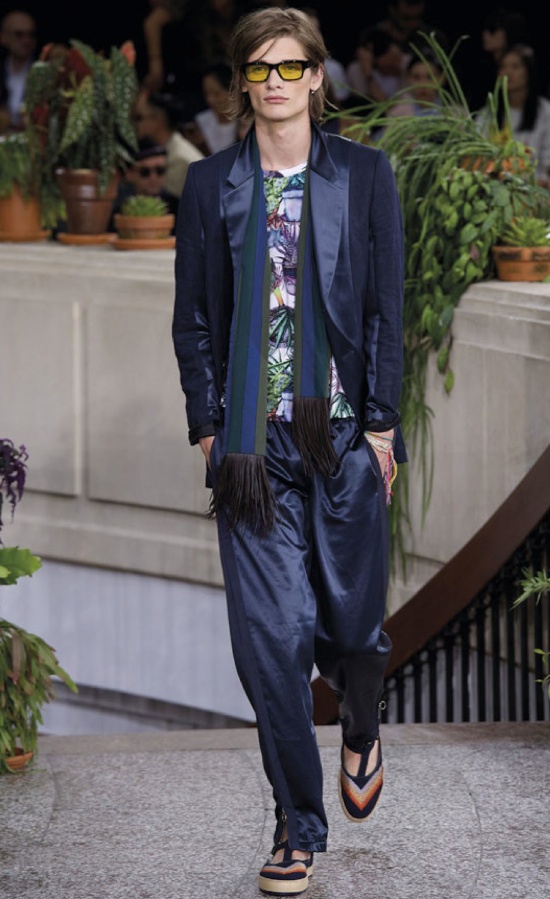| P E O P L E |
SIR PAUL SMITH
Designer | London
With an electrifying magnetism and a refreshingly down-to-earth view of the world, Sir Paul Smith oozes positive energy like an active volcano. We sit down with one of the world's greatest creative minds to find out more about his inspirational life's journey.
Walking into Sir Paul Smith’s private London office is like discovering the design lover’s equivalent of Charlie & The Chocolate Factory. Thousands of books are piled high on every surface, framed photographs and sketches line the walls and floors, and a mish-mash of curious objects collected by the designer during his 44-year career sit proudly displayed across every square inch of his shambolic treasure trove. “There is order in this chaos”, he insists with a smile, while climbing onto his pink bicycle and riding it around the room...
If you spend even five minutes with Sir Paul Smith, or “Paul” as he insists on being called, you’ll be injected with his infectious sense of fun, his childlike curiosity, and his fascination with everything that the world has to offer. He is one of the world’s most celebrated British designers who has been in business for over 40 years. His brand is sold in 66 countries and he has 17 shops in England alone. Despite leaving school at 15 years of age and being diagnosed with dyslexia as a child, he currently employs over 3,000 people around the world and his privately-owned company has an estimated worth of over GBP 1 billion. He has 14 separate collections, and his impeccably tailored men’s and women’s fashion and accessories lines are worn by discerning musicians, actors and fashionistas worldwide. Described as a “creative with his feet on the ground”, he shuns the typical celebrity spotlight and favours simple, down-to-earth values. He’s also quite likely to spontaneously jump on a plane because he wants to see the Great Wall of China, then return home on the same day, because he has one day free in his incredibly hectic agenda. “Why not?”, he says with his trademark grin. A man who needs no introduction, we find out more about the pre-eminent British designer who maintains a "childlike" view of the world...
How did you originally get into fashion?
PS: I started many years ago. I left school when I was 15 actually. Originally, my dream was to be a racing cyclist. I got my first bicycle when I was 12 years old, then I was a racing cyclist until I was 18. I had a bad crash and I was in hospital for six months. Around the same time, I met up with people from our local art school. The rest, as they say, is history because I was suddenly introduced to Pop Art, the Bauhaus, Warhol, Kokoschka and all of these other names that were a mystery to me at the time. I suddenly became fascinated by the world of creativity. I thought, "I wonder whether you can actually make a living doing something which has to do with creativity?" One of the girls I met there was starting a little clothes shop and she asked if I would help her out by finding and decorating a shop with her. She'd make the clothes and I would sell them as the shop manager. So that's what I did. That was fantastic because I actually didn't know anything about getting a lease for a shop, talking with lawyers, decorating the shop, doing the window display. Three years later, I met Pauline, who became my girlfriend and is now my wife. She had two children, lived in London and trained at the Royal College of Art. She looked so beautiful. She came to live with me, and suddenly, at the age of 21, I had two dogs, two cats and two kids. I'd previously been living at home with my mum and dad, so it was quite a shock, I can tell you! Both the dogs looked exactly like me. They had long hair and a big nose because they were Afghan Hounds. It was difficult to know sometimes which was the dog and which was me. It was a fantastic growing up period because, suddenly, I was a father of a 5 year old and an 8 year old, and had a lot of responsibility.
When did you create the Paul Smith brand?
PS: After six years working as a shop assistant, Pauline gave me the energy and the enthusiasm to start my own little shop. I'd been working for about one year on my free day, which was a Monday, earning some extra money. With £600 and a room that was only three meters square, I opened something I called a shop. It absolutely wasn't a shop. It was a room. It was only open on Fridays and Saturdays. That was the start. I'll tell you the date that I started. I'm very, very old, you see. I started my little shop on the 9th October, 1970. Homer the dog was the manager of the shop, and I was his assistant – so that was very nice. For the rest of the week, I did anything that came along. I was a stylist, a colourist, a photographer. I worked with many of the early magazines and eventually worked with publications such as Face and Arena – I still work with magazines today as a photographer, and also shoot all of my own campaigns. My life was quite varied back then. Pauline was my teacher and she's the absolute reason why I'm here now because we're still in love. We still live together. She's still my inspiration. Because she trained at the Royal College of Art during the time when couture was still being taught, she taught me about the importance of how to make and construct clothing. Today, a lot of the teaching is very much about the image, the marketing, the networking as well as designing, but not so much about the effort of cutting a pattern, making the toile and how clothes are actually constructed. She taught me that, and it was quite old school, but that was a key thing for me. That has meant that Paul Smith has always been well‐cut and beautifully made. I used to come to Paris with her when I was around 22 or 23 years old. The Chambre Syndicale de la Haute Couture very kindly gave us tickets to go to the couture shows back then, in Paris, so we saw Chanel, Patou and Courrèges. That was mind‐blowing, so fantastic, because it was all about the simplicity and the cut. You'd go there and there were two shows a day for two weeks. There was only about 15 people in the audience, no music, just the designers there with their pins and a few clients. It was wonderful training. From 1970 to 1976, I spent six years doing lots of things. In 1976, I made a very small collection and I took it to Paris, to a hotel called Hotel Odéon in Place de l'Odéon near the famous La Mediterranée restaurant, where Jean Cocteau used to go. I took a hotel room – a tiny hotel room, very basic – and that became my showroom. I got some black fabric and threw it over the bed. I think we had about six shirts to show on the bed – then I opened the wardrobe door and we had a spotlight. I think I had two jackets and one pair of trousers. During that period from 1970 to 1976, I'd been doing lots of freelance work, so I'd heard about the buyer from Barney's department store in New York and Seibu department store in Japan. I sent invitations to them, saying, "I'm Paul Smith, and I'm showing my collection." On Monday, nobody came. On Tuesday, nobody came. On Wednesday, nobody came. On Thursday, still nobody. I was about to pack my bag and go home, but then at four o'clock, I had one customer. Suddenly, I took an order. That was my first order. "Phew!" That was so lucky. That was the start.
Is it true that some of your first customers were young, up-and-coming musicians such as Led Zeppelin, David Bowie and The Rolling Stones?
PS: Yes, that's right. I lived in Nottingham, in the middle of England. I had a good friend at art school who taught me how to do silkscreening, which you always do by hand. You build a wooden frame with silk, then you cut out the design. Much to the horror of my mum, I used to do the silkscreen printing at home – the smell of the ink was incredibly strong! I made some designs, I bought some basic, low‐cost plain white t‑shirts. Then, I silkscreened them very carefully. My dad bought me a 1948 Morris Minor car that cost around £21. Every weekend, I used to drive from Nottingham to London, which back then, used to take around five hours – it was so worth going though. Back then, you could go to see really great bands above a pub or at the Railway Inn at Hampstead, or the Tally Ho in Kentish Town. Then, of course, there were the important clubs in Central London – the 100 Club in Oxford Street, Whisky a Go Go in Soho. Often, after the gig had finished, you could go on stage because there weren't any changing rooms for the bands. I'd say, "Hello. I really enjoyed your set. I like the new album." Occasionally, one of them might say, "Oh, what's your name? What do you do?" I said, "Oh, I'm Paul. Hello. I'm a young designer. Do you want to buy a t‑shirt?" I'd always have a t‑shirt stuffed in my bag or in my pocket. Often, they did buy t‑shirts. So I sold t‑shirts to Eric Clapton and to Rod Stewart when he was 18 and a very good singer. His image was very different then. I've just done a very big project with Jimmy Page. I've been making clothes for him since I was 18 years of age. Later on in my career, I worked with people like David Bowie in 1979 and 1982. Just recently, we designed some clothes for The Rolling Stones for a recent trip of theirs to Australia. That's why I’ve got this strong link with the music industry, because of those early days. A lot of the bands still come in here now. There's a young British guy called Jake Bugg who's a really nice singer. I think he's 19 or 20. He's from my hometown of Nottingham. Cyclists, musicians and actors seem to come and see me all the time. They just ring up so it's quite beautiful.
Now that you're one of Britain's most emblematic designers with hundreds of stores around the world, what did it take to arrive to the Paul Smith of 2015?
PS: I think what was interesting about my life and my career from the age of 21 was meeting Pauline. She's very calm. She's never aspired to have big cars or airplanes. She's not a financially motivated person at all. She's a painter now. She was a fashion designer. Now, she paints and she's a dancer as well, which is really lovely. She's very well‑read. She is just this lovely, calm person. My father had a big influence on me too as he had really strong communication skills. He was really skilled at making people feel at ease. The combination of Pauline's solid background and my dad's quite vivacious way seemed to be what I inherited. We started Paul Smith with £600. I've always had this skill somehow – I suppose you call it a skill – of earning money but also having a strong image. I do two catwalk shows a year for men and two catwalk shows a year for women. But, also, I have quite a big jeans business and a classic suit business. It's this balance between having a strong image and doing things that pay the rent and keep the cash flow coming into your company. A lot of companies tend to have either one or the other, but they don't have a balance between both creativity and cash flow. So if you only have creativity, sadly, often, you run out of money. If you only have cash flow, then you have no character.
How did the Paul Smith brand grow over the years?
PS: The interesting thing with my company is that its growth has been very gentle. It's never been like a rocket. People often say to me, "When did you really feel that you were taking off?" The answer is never. I mean, because it never really went like that. It always went just gently. The magnificent thing is that we have never borrowed any money. We're an independent company. We're not in any debt to any bank anywhere. We've never borrowed money. We own this building. We own our warehouses. We own the Milan building, the Paris building, etc. We're very solid. I think that's just because we've done it very gently, very honestly. That's why we've had longevity, I think, because we've kept our feet on the ground. Now, we employ about 1,000 staff here in Europe and 3,000 in Japan through our licensee, but also 35 staff directly. We've got shops in many, many countries. In this building, our London studio in Covent Garden, there's 200 of us. There's the design floor below here where we have about 25 print and textile designers and also actual clothes designers. There's 4 collections for men, 3 collections for women plus accessories, shoes and spectacles. What's unique is that in this building, we also have our very own shop design team that includes three architects and nine interior designers working there. Every shop we do around the world is individual and different, which is, of course, quite opposite to a lot of the big brands where the shops are virtually identical around the world.
How would you describe the Paul Smith aesthetic?
PS: I suppose that it's very much about my character – about being individual, trying to be different than the run of the mill and not going along the typical path. I've always tried to think very laterally, so not down the obvious route, because the obvious route is the route that many people are taking. It's like buying yesterday's newspaper, the obvious route. About my London office, you could say, "It's like a kid's room." Yes, it's true, but I pride myself in thinking in a childlike manner, not "childish", childlike. I think it was Picasso who said that he spent his life continuing to have the freedom of a child in his mind because they're very honest in the way they do things. What I try to think is, “Why can't we do that” and “What about this” and “What about that?” Being childlike, I think, has kept the company really down to earth. The company today is really the same as it was in the early days – it's just a bit bigger now. It's got a heart, and not many companies have a heart. They just have a wallet.
What does "a day in the life of Paul Smith” look like?
PS: I've always worked very hard as a person. I left school at 15. I left school on a Friday, and I started working at a new job on Monday. I never even had a holiday. I've always worked every day of my life. I've always been very optimistic and very full of energy. I'm blessed with good health. I think it was in 1993 that I started swimming every morning. I swim every morning at a club here in London, and if I'm in Tokyo or Paris, I choose a hotel that has a swimming pool. If I can't swim, I cycle. I keep a bike in Paris, Tokyo and Milan. I swim every morning, but I'm not a very good swimmer. It's not like up and down for 50 lengths. Sometimes it can be for 10 minutes, sometimes it can be for 30 minutes. It's just great because it opens up your body and relaxes your mind. You've got to have a shower anyway! I start the day with a swim at 5:00 a.m, then arrive in the office at 6:00 a.m every morning. It's wonderful. There's nobody here apart from the cleaners. Then I get about an hour and a half of free time. Maybe put on some vinyl, listen to some music: Herbie Hancock, Van Morrison or Jake Bugg, whatever I fancy. I make some phone calls to Japan, nine hours ahead, or San Francisco. Then at around 7:30 a.m, there’s the first appointments with my staff – there's a lot of people in this building. I work really hard every day, from 6:00 a.m. until 6:00 p.m. Every hour there's an appointment. It goes like that all day, and it's fantastic. I love it. There's a design room downstairs. We've got all of our social media team in the building. We've got shop designers in the building, showrooms in the building. There's such a great energy in here. I also tend to travel most weeks.
Where do you love to travel to?
PS: I actually do these very funny day trips. About 15 years ago, I realised that my schedule was so busy that I couldn't really go to some of the places I've always wanted to go, like Hanoi or the Great Wall of China. So I started doing these day trips. I went to the Great Wall of China for the day. I went to Cambodia for the day, I went to Vietnam for the day, to Delhi for the day. I always told my friends, "I'm just going to Delhi, I'll be back soon." I arrive at midnight and leave at midnight. If I go to Delhi for the day, I'll take lots of photographs, I'll buy fabric, I'll look at a few monuments. Last time I went, I bought 15 wardrobes in a day. They're here somewhere. They're in one of my shops in London Bridge. I’ll buy pieces of furniture or antiques. When I went to the Great Wall of China, there was something very magical about climbing up. Now it's very touristy, but I went to a really remote part and went all the way to the top. You can see Mongolia and the Gobi Desert. The air, the freshness, the silence was amazing. It was just me, nobody else. I left my guide down at the bottom. He said, "Can't climb." He said he was too tired.
How do you see the world evolving today?
PS: One of the problems of living in the world today is that we're so bombarded with information. Now, by looking on the Internet, you can find out amazing things within 45 seconds. Of course, that's wonderful, but in the past you would have gone to a library to look at books. That means you would interact with a person, and then you'd feel the texture of the book – you would open the book and you would feel the weight, and you would observe people looking at other things. Life's changed a lot. Often, unfortunately, people are not so honest with themselves because they're not as pure as they used to be, because they're so influenced by, "Oh my gosh, that person's earning that much money or that person's got six jobs or he drives that car. Maybe I should be doing this or maybe I should be doing that." If you can be brave enough and you can be blessed, like I was, with finding Pauline, it's so important to just be yourself. You have to be quite brave to be yourself. Sadly, I think there's so much insecurity in the world now because there's such a bombardment of influences. It's quite hard to feel at ease with yourself inside. This insecurity is very evident in fashion because so many people want to buy fashion that indicates they are wealthy or that they are part of a fashion club. They like the logo to say, "I am part of this club." Or drive a certain car because they want to indicate something. That's very obvious and has been around for years. Sometimes you can just say, "I am me."
Based upon your experiences in life, what would be the main advice that you would share with the next generation of designers and creators?
PS: I think the key thing about anybody who's starting out in the world of making movies, making films, making documentaries, writers, chefs, designers, is that, honestly, nobody needs another designer or another newspaper or another magazine because there are already so many in the world. If you ask yourself, "What's my point of view? Why should somebody employ me? Why should somebody buy the clothes from me?" Of course, the answer is huge because it's about whether your product has the right cost, the right shape, whether your image is good, whether your production is good, the quality is good. It's about a lot of things. My recommendation to a young designer would be to just get out there and know the world of fashion. Live it, breathe it, immerse yourself in it. If you're a graphic designer, know graphic design from 30 years ago and know about doing things by hand, not just by computer. I even say to people, "Work in a bar at the weekend because you're learning life skills, you're learning communication skills, you're learning body language, and also you're learning organisational skills." You can learn so much from ordinary things. Also, look around. Enjoy seeing shadows, enjoy seeing texture, enjoy graffiti, enjoy stuff because that's what creativity is about. Creativity is about looking and seeing, not just about looking. Try to be interested and interesting. Try to learn to know when to listen and when to talk. Be proud. That's a good tip, I reckon.
Interview: Enrique Nalda & Kimberley McLoughlin
Photography: Courtesy of Paul Smith
Interview first published in RedVisitor Magazine: Issue Two - Purchase Now
M O R E I N T E R V I E W S . . .







